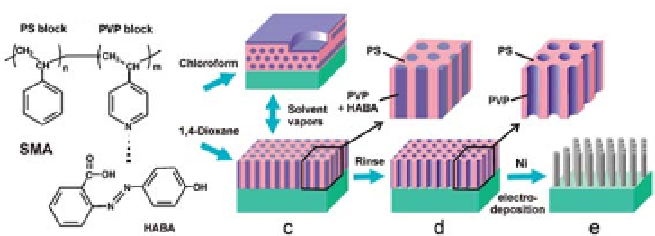Biomedical Engineering Reference
In-Depth Information
weight additive with the copolymer, chosen to segregate selectively
into one phase. After microphase separation (also typically modified
by the presence of a further component) the molecule can be
released from the structure by soaking in a selective solvent for the
host copolymer block. The copolymer microphase is not destroyed
providing that the majority component remains insoluble. Two
well-studied systems of this type are poly(vinylpyridine) (PVP)
containing copolymers hosting either 2-(4-hydroxybenzeneazo)
benzoic acid (HABA) or 3-pentadecylphenol (PDP) molecules [70,
71]. To date, this method has only been applied in very thin layers
(~40 nm) where selected solvent interactions can switch orientation
from lying to standing cylinders. Sidorenko
. used these films as
electrochemical templates for 40 nm long standing nickel nanorod
arrays some 8 nm in diameter (Fig. 2.8).
et al
Figure 2.8
-PVP):
small molecule (HABA) assembly. Reproduced with permission from
Ref. [71].
Porous electrochemical templates from copolymer (PS-
b
The same selective dissolution method can in fact be used even
without an additive. When the minority component is selectively
solvated then dried, the chains are left coating the matrix phase of
the majority matrix. In an ultrathin film, the chains also migrate
to cover the free surface on drying, leaving an empty pore in what
was the center of the minority domain. Porous arrays up to around
30 nm thick based on PS-
b
-PMMA [72] (trifluorotoluene as selective
PMMA solvent), PS-
b
-PVP [73] and PMMA-
b
-PVP [57] (ethanol as
PVP solvent) have been created in this way.









Search WWH ::

Custom Search